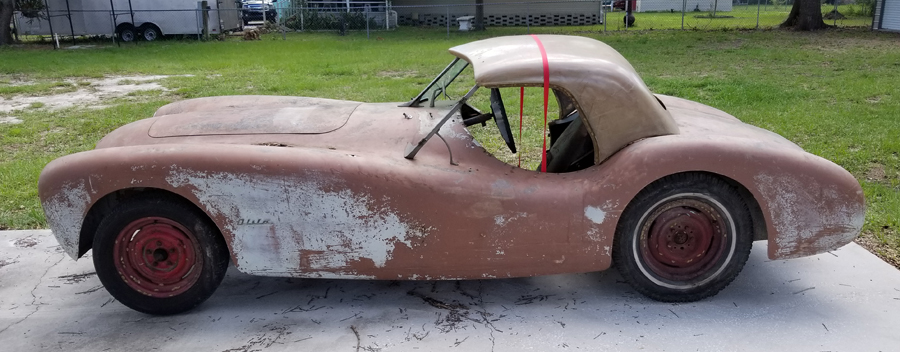
Tony St. Clair’s Glasspar G2 – Next In Line To Begin Restoration at Undiscovered Classics
Hi Gang…
I’ve been waiting to tell this story for 10+ years. And this week the saga begins – for Tony St. Clair, myself and all of you who are part of Undiscovered Classics.
Glasspar Found: Detroit
Back in 2008, Tony had found a Glasspar G2 for sale on Craigslist near Detroit. The price was fair it wasn’t far from his home in Liberty, Ohio so a deal was struck and a new car added to Tony’s stable.

Tony picked up the car and stored it for future plans. From time to time, I would check in on him and the car when we were driving thru Ohio. Luckily for Tony’s car, he was able to keep it inside until restoration plans were put in place.
Recently Tony felt the time was right and he sent the car to us at Undiscovered Classics to see the car through its restoration and return to the road. Let’s check out some photos of Tony’s Glasspar G2 to see what we have to start with:
Assessment:
So what do we have to work with? What is the history of the car? There’s actually a lot you can learn when reviewing the car bit by bit. And given that we’ve seen so many of these specials in different states of dis-repair, we can make some assumptions based on what we see – and don’t see. Let’s review this car as an example.
The body is in excellent shape, but the top looks “new.” I can explain that. Guess who borrowed Tony’s hardtop many years ago to make a mold of it so we could offer to other Glasspar G2 owners? Yes that would be me. And we’ve sold a few too. We had to restore the hardtop that came with the car in order to pull the mold so that’s why the hardtop looks new.
But wait…there’s no driver’s door. That’s easy to explain too. Bill Tritt gradually added doors as he gained confidence in the strength of the body. When I was interviewing Bill about 10 years ago, he said the strength was a concern to him so the first body had no doors – the Brooks Boxer. The second body was Alembic 1 and this had only one door – the passenger side. Bill worked out strengthening the body using aluminum door jambs and an aluminum sill plate.
Then he started offering two doors if people ordered them. In any event, this may have happened over time because the presence of just one door (always passenger side) usually means this is a body built in 1952 or early 1953. Usually – not always – because customers could order what they so desired. So this may be a car built in 1952 (foreshading here). Let’s check out the passenger side and front.
As I was alluding to, we have just one passenger door on this car which points to a high probability it is an early car. The front grille is the standard cutout for a Glasspar grille which also means it’s not one of the cars custom fitted for a Nash grille.
Click Here to Learn More About Glasspar G2 Cars Fitted With Nash Grilles
The fitted hardtop (an option) and the Glasspar windshield posts are all still with the car. Often this means that the car was put away years ago and spent most of its life undamaged inside or protected outside. Still it looks like someone started the restoration perhaps decades ago and then stopped.
There are other clues that this was a finished car at one time. Windshield wipers installed means the builder was building his own sports car to drive – in expected conditions. Fender mounted mirrors (holes) mean the same. Based on our experience, this was a finished, running/driving car probably in the early to mid 1950s.
What can we learn by looking at the cockpit? Let’s begin.
The installation of a rear view mirror again points to a finished, running, driving car at some point in the distant past. An interesting feature are window defogger vents. Another point reinforcing a highly built car at one time.
Tonneau cover snaps show that a tonneau was a finished item as well. I would have loved seeing the dashboard but it’s gone – maybe a “lost” valuable item over the years but again it would have been an interesting piece to have seen to infer the level of finish. Not sure why the steering column is so high. That’s not typical. It may be loose or have been replaced. Research will be needed here.
Glasspar Door Tag
Check out the door tag below. Glasspar installed these on the passenger side of the car. We’ve found some relocated from time to time but the default location was on the passenger side, front door jamb. Rodney Packwood deciphered these many years ago.
Close inspection reveals the tag number as “G21052187”. This is a standard format for a Glasspar tag and car as follows:
- G2: Car Body
- 10: October
- 52: 1952
- 187: Body Number #187
In Rodney’s work with Glasspar, all tags found so far start with “100” and do not exceed “200.” So Tony’s car body was finished/tagged in October, 1952. Indeed a late 1952 Glasspar G2 which could have easily been finished in 1953 or early 1954. But as they used to say on late night commercials (I miss those)….”wait….that’s not all.” In this case, that means there is more to share.
It’s All In A Name: Olila
Each fender is badged with a name – “Olila.” These appear to be handcut from brass and chromed. What does this mean?
Very few cars were “badged” on the side of the fenders, and this would be another indicator of a high level of finish of Tony’s car. The second Glasspar G2 built, the Alembic I, had an “Alembic” badge on the side of it. Perhaps whoever built Tony’s car had seen the Alembic I or there may be an association of sorts with it? Again….research needed here.
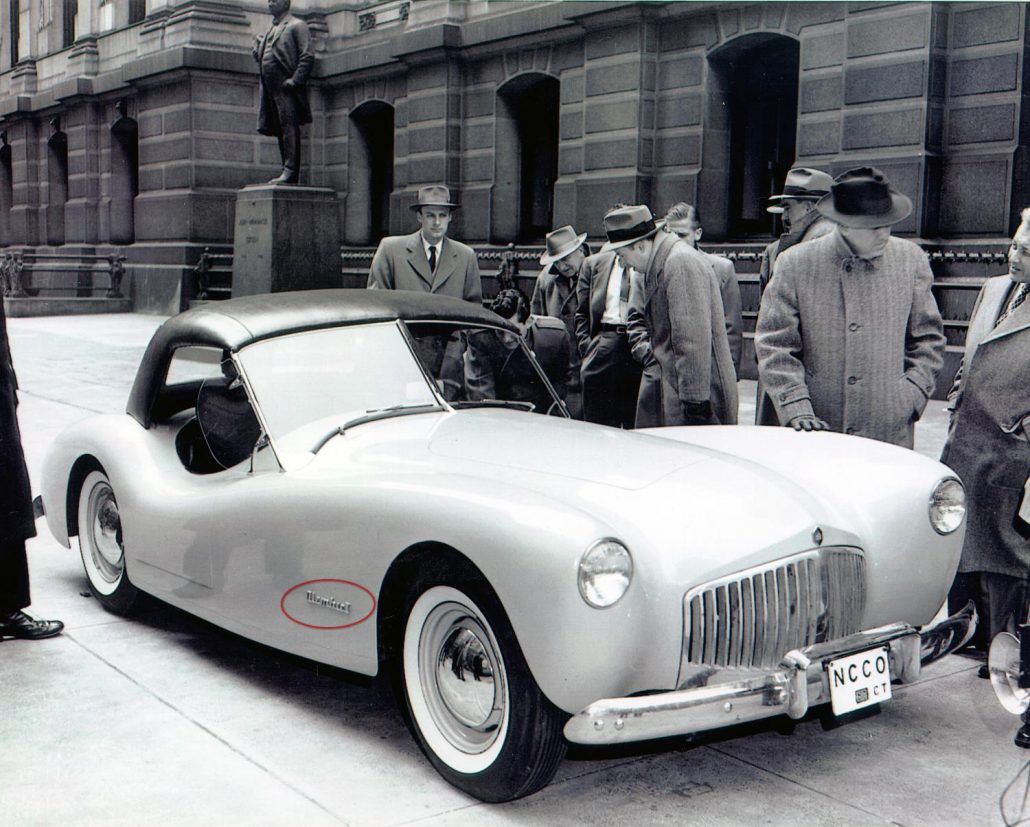
There’s the Alembic I arriving in Philadelphia in early 1952. This was the company car for Naugatuk Chemicals which helped bring the Glasspar G2 to reality by assisting with resin for the the Glasspar Company and more.
How About the Chassis
Tony and I wondered about the chassis for years. Mainly because of the front spring – I’d never seen anything like it and had always assumed that it was some obscure or rare chassis.. Check out the photo of the front spring configuration below.
Earlier this week when I dropped the Glasspar off to Ralph Smith, we finally were able to put it together. When Ralph and I were inspecting the front end, he noticed where the front rails had eyelets for longitudinal springs. Years ago Erich Schultz schooled me on Willys use of longitudinal springs front and back. Hmmmm.
The 1940 Willys chassis with a 102 inch wheelbase was the choice of chassis for the first two Glasspar G2’s – the Brooks Boxer and the Alembic I.
Click Here To Learn More About Willys Chassis Used for Glasspar G2 Sports Cars
But what else confirms this is a Willys chassis? What about that ID tag on the front cross member? See photo below.
Right on the money. This is a Willys tag. And the rear end looks a match to a Willys too. Is this car related to the Brooks Boxer or Alembic I? If it is, the body tag suggests different. The first two G2’s were made in 1951 and the body tag of Tony’s car shows a body “build” date of October, 1952. More information to consider and research.
First Step:
Tony chose a 1955 Studebaker V8 motor with matching transmission to power his Glasspar. He found a nice donor car and Ralph Smith began work and pulled the drivetrain. The Studebaker is now being offered to a new owner who has plans to replace the drivetrain anyway so all are winners here gang.
Out With The Old (1955) and In With The Older (1952)
Before I drove away with the Studebaker in tow, I took a photo of the Glasspar with its donor car in the background. A nice way to show how these cars were built back then and the process of how they are being restored right now. Some things never change.
Summary:
Tony and I were discussing the points made in today’s story about his car and he brought up the fact it was found in Detroit. Might it be related to a test or build by another company related to the Detroit manufacturers. An interesting question. I also googled the “Olila” name and there are folks in the Michigan area with this last name, so it might be a car that one of the Olila family members built so another item to research.
So….hope you enjoyed a bit of “behind the scenes” peak into the process of research. Doing this type of work on American Special has become what we’re known for, so we’ll see where the leads take us with Tony’s Glasspar. And of course perhaps more information will be uncovered during restoration which starts soon down here in Tampa, Florida.
Hope you enjoyed the story, and remember…
The adventure continues here at Undiscovered Classics.
Geoff
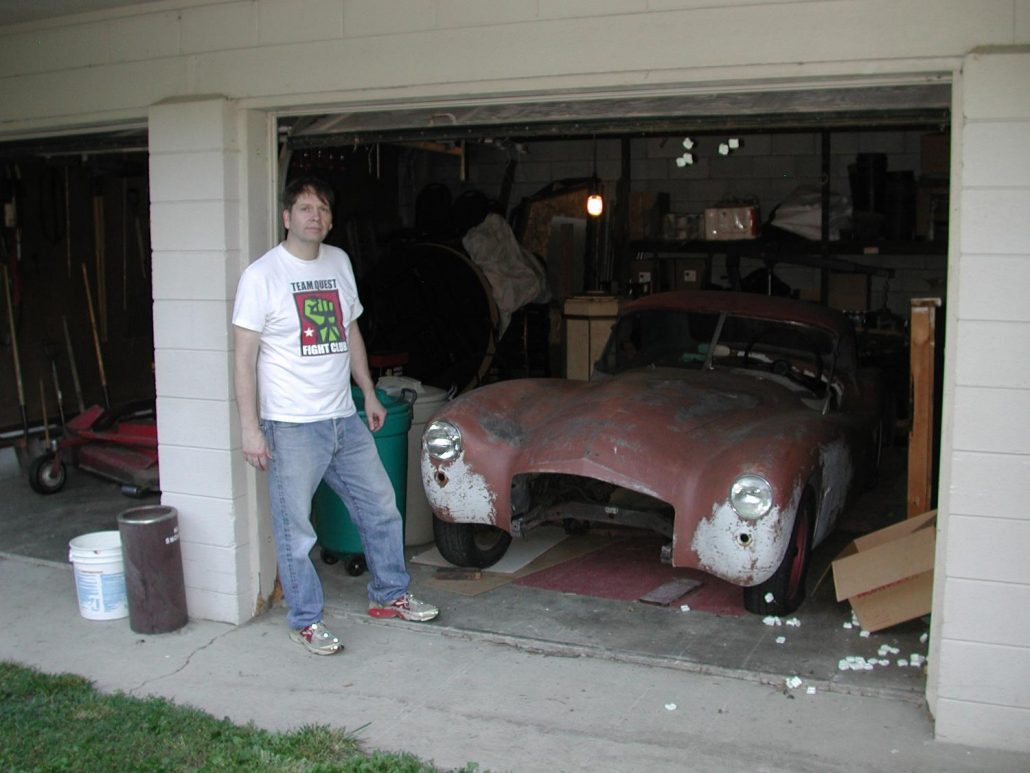









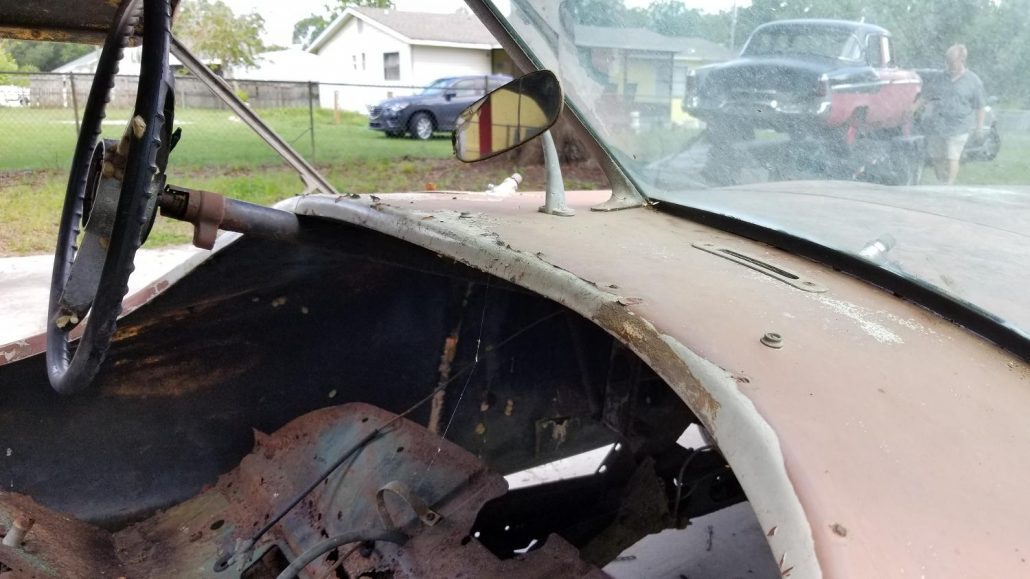
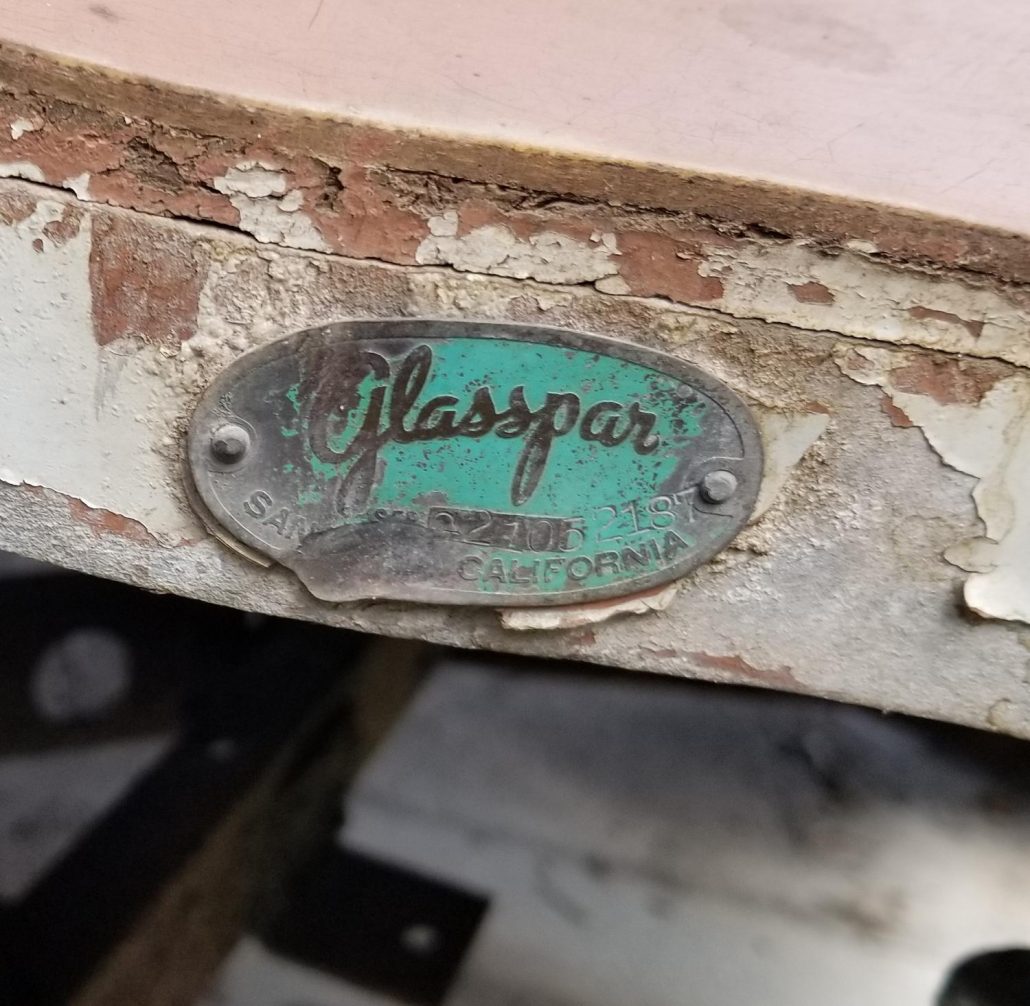
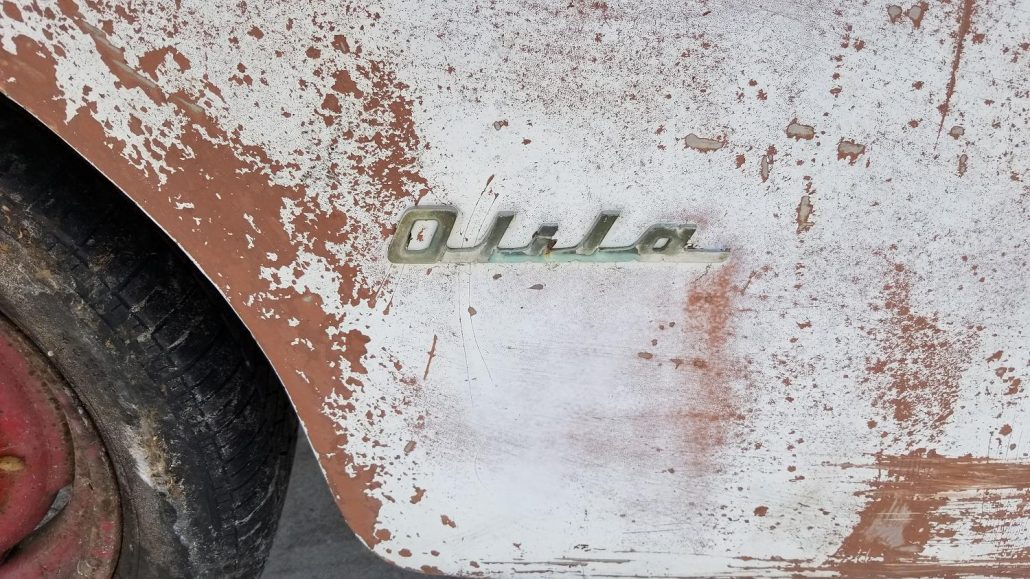
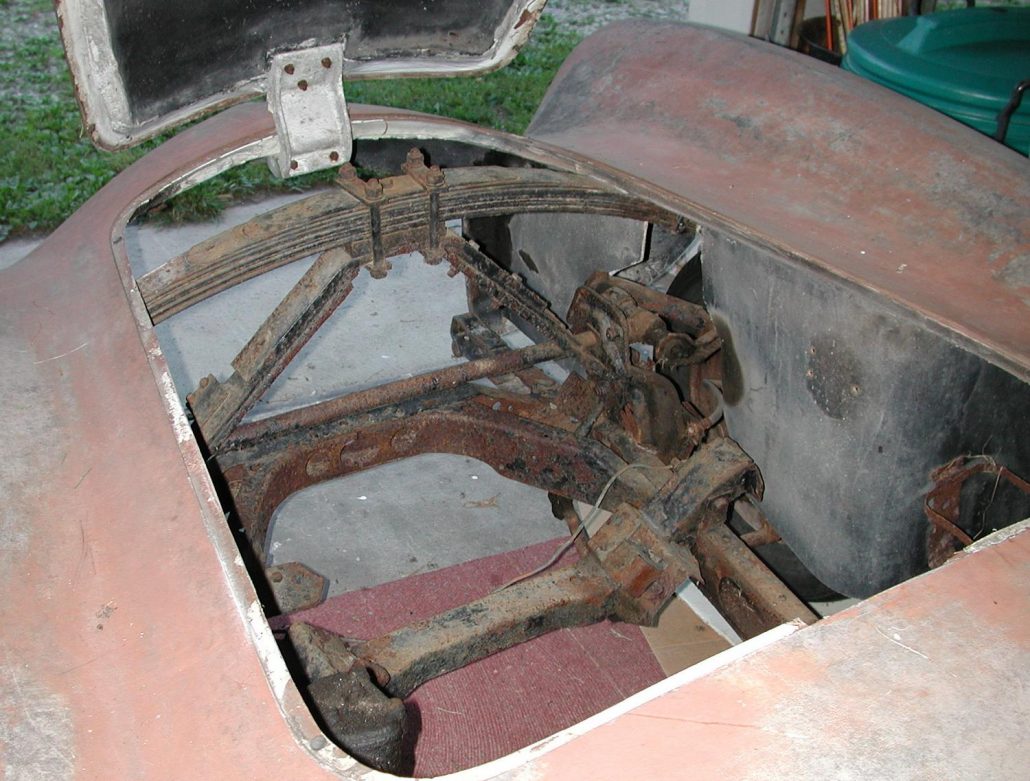
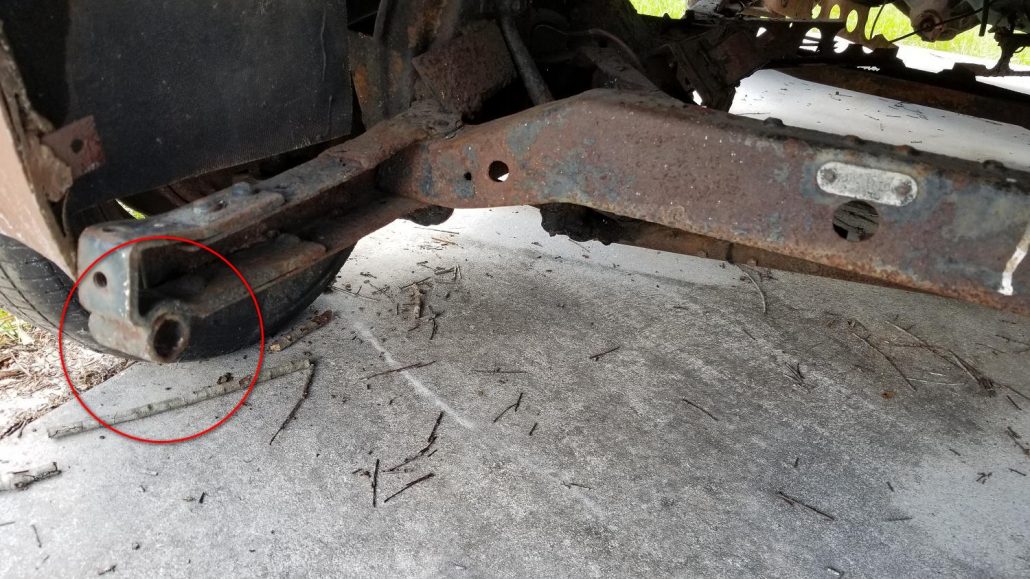
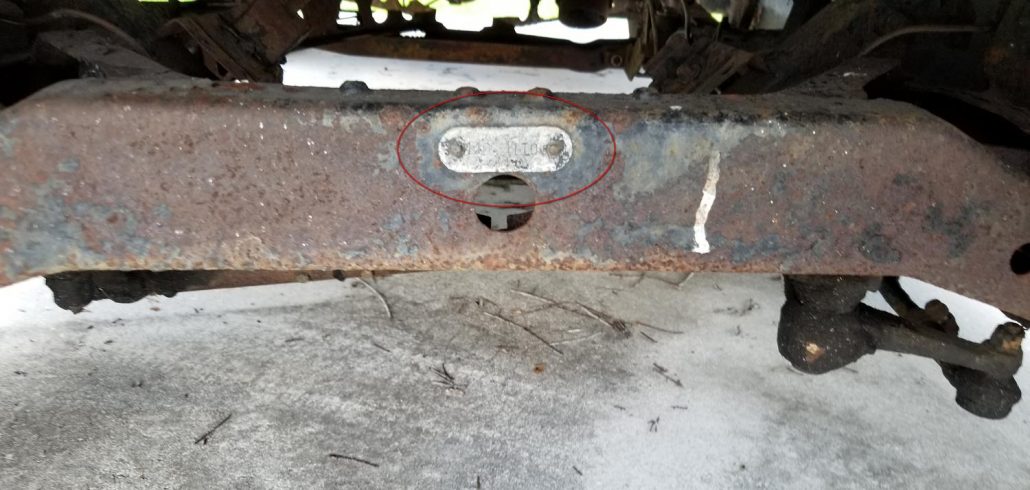

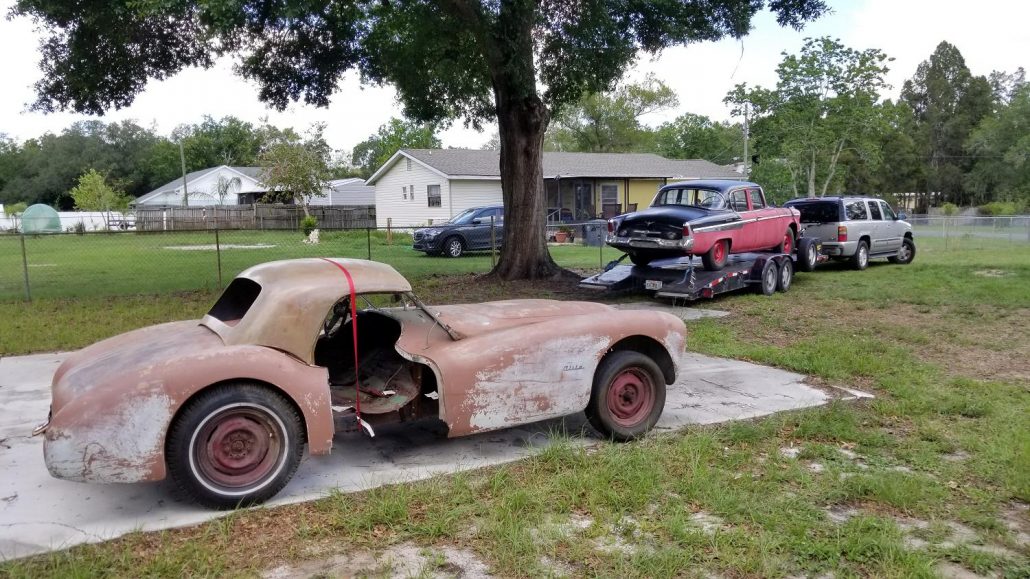
It’s great he is sticking with a period drive train. Hopefully the same thing happens with the interior and wheels.
These old “glass” cars are so cool!I just wish I’d gotten in on building them while they were in their infancy. I had plenty of opportunity to repair fiberglass street cars and race cars, but nothing quite like these lost gems. Very cool!
Geoff,
Glasspar was well known as a manufacturer of aftermarket fiberglass hardtops for Porsche 356A Speedsters. They were very well made and had rear quarter windows that opened. Fibersteel makes an excellent continuation of the Glasspar hardtop.
Geoff,
Great article on this Glasspar G-2. It’s been awhile since we figured out the fate of Alembic I and II. I still think about those cars quite often and would have give anything to see one or both of them in the flesh. It sounds like you guys are doing a lot of great restoration work. I’ll be interested to see what this Glasspar looks like when you are done with it.
The name: Olila
My guess is a version of:
O’ Lila
Oh Lila
I can only add what has already been said. Another wonderful story that reads like an adventure in archaeo-automotive history!
Indiana Jones ain’t got nuthin’ on you Geoff!
For many years I had a Glasspar G3 ski boat that was sharp looking and well made.
It impresses me how professionally and seriously the builders of the Glasspar bodies were taking their business. To start building car bodies in 1951, and assigning serial numbers from the beginning, which provides a provenance for research 68 years later. It also helps the modern car builder with a VIN for titling and registration.
Depending on the state DMV requirements this car could be titled as a 1940 Willys or a 1952 Glasspar (In my state it is whatever the body “most resembles”, so it would be a 1952 Glasspar even if it was sitting on a 2020 chassis and drivetrain).
@Mark – There’s a lot to be impressed with concerning Glasspar. So far Rodney Packwood and I can account for around 75 of the 100 cars/bodies built – and that’s in 2020. The survival rate for these cars is huge and much of it has to do, most likely, with a beautiful design and high quality “build.” Glad you enjoyed the story and thanks for your support. Geoff
Geoff
What a Great story and History Lesson about the Glasspar G2.
Really enjoyed this and am looking forward to the upcoming restoration story.
Regards, Dennis Gerdes
@Dennis – glad you enjoyed the story Dennis. I included some detective work to help others learn some of the specifics on Glasspar so hopefully that didn’t bore folks too much. Thanks for your support. Geoff